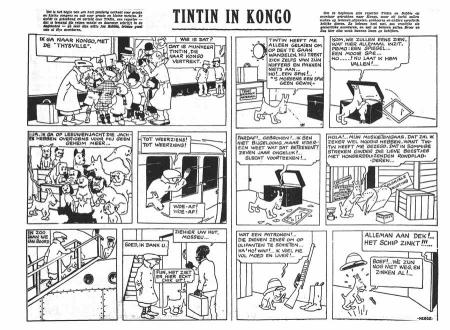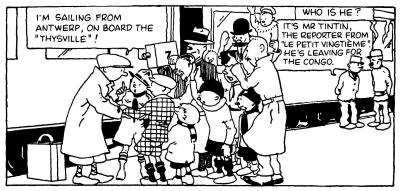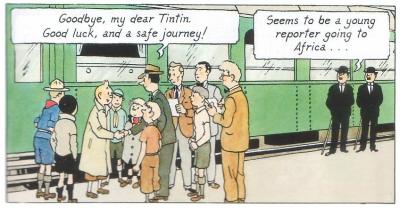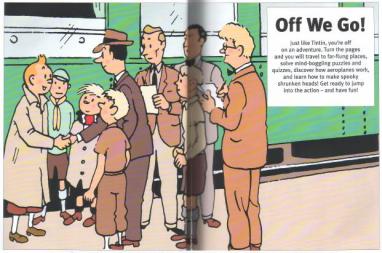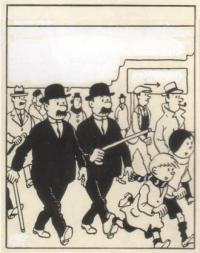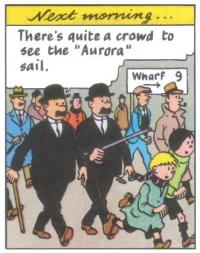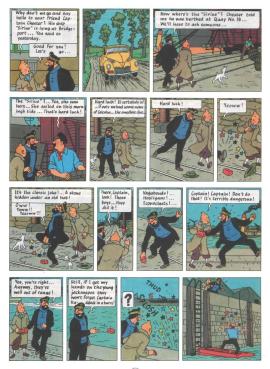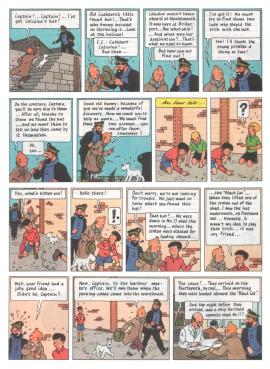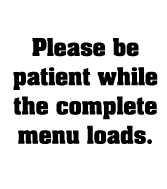 |
13 Cameos of Hergé, Tintin,
Click here for Herge Main Page | 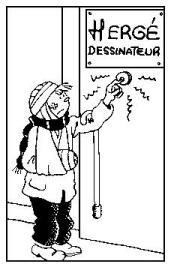
|
|
A cameo role or cameo appearance (often shortened to just cameo) is a brief appearance of a known person in a work, in this case a cartoon strip, where they are unexpected and do not play a role or only a small, non-speaking role. A cameo appearance can also be made by the author of a work to put a sort of personal "signature" on a story. Possibly the most well-known series of cameos was by the director Alfred Hitchcock, who made very brief appearances in all his films. On this page, we'll see two different types of cameos: 1) characters from one comic strip making an appearance in another one and 2) the cartoonist making an appearing in the comic strip. Mr. Mops and Quick & Flupke On the left, Flupke (or a boy who closely resembles him) appears in the 8th and last Amicable Mr. Mops strip, part of a 1932 calendar created for the "Au Bon Marche" department store. On the right, poor Mr. Mops makes an appearance in the Quick & Flupke strip, "Innocence," which appeared in Le Petit Vingtième and later in the book Attachez Vos Centures, (Fasten Your Seat Belts) pg 36. Shown here is the English translation by David Radzinowicz from the Egmont book, Fasten Your Seat Belts, 2009. |
|||||||||
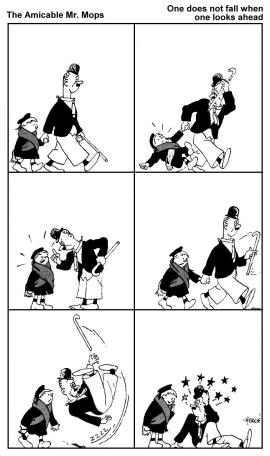 |
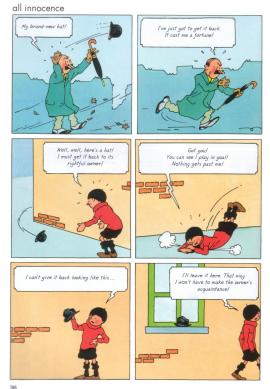 |
 |
|||||||
Tintin appears on Quick & Flupke book covers and vice-versa Tintin makes an appearance on the covers of two Quick & Flupke books. He appears in the first series of Les Exploits de Quick et Flupke, 2e serie as a photo on the wall and on 10e serie as a movie poster on the street. In return, Quick & Flupke appear on the back cover of many TinTin books from the 13th one on. Flupke is taking aim with a slingshot at either Capt Haddock or his bottle of whiskey. We also see Jo, Zette, and Jocko at the left next to the text block. (Click on any image for a supersize image.) |
|||||||||
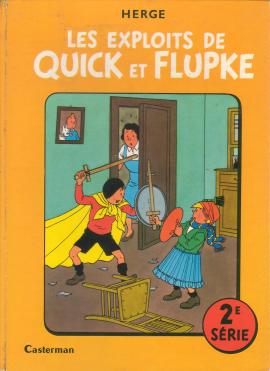 |
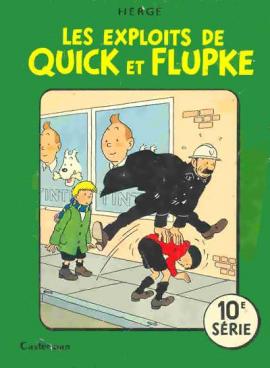 |
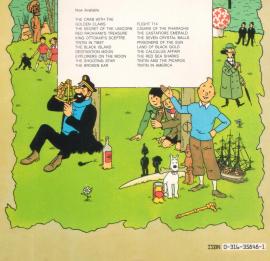 |
|||||||
Hergé appears in Quick & Flupke comic strips Hergé drew himself into more Quick & Flupke comic strips than any of his others. For one reason or other, he most often interacts with Flupke, although both boys are involved in some of the interactions. In one case, it is Flupke only talking about Hergé and we don't see him at all; in another we see only his hand; but in three strips, Hergé himself appears. (Click on any image for a supersize image.) |
|||||||||
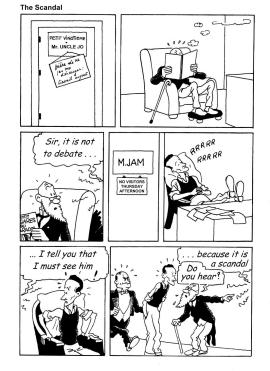 |
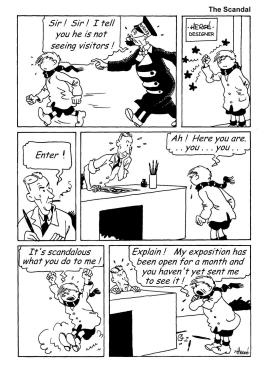 |
This strip, "un scandale," appeared in Le Petit Vingtième and only in the book, Hergé Archives, vol 2, pages 236-37 published in 1978. As far as I know, it was not colored and did not appear in Tintin magazine or any books of the collected strips. It also contains the only known cameo of Paul Jamin (Jam), who tended toward satire, humor, and political caricature for 6 years at Le Petit Vingtième. The "Uncle Jo" on the door refers to editorials in Le Vingtième Siècle that were signed "Uncle Jo" but were actually written by Hergé, then by Jam, and later by others. English translation (left) is by me, David Ahl. |
|||||||
In this next strip, "cruaute" (cruelty), Herge does not appear at all, but Flupke speaks about him in the last panel. |
|||||||||
It originally appeared as a 2-page, 8-panel strip in Le Petit Vingtième (below). It was later reformatted into one page for the cover of Tintin #200, 21 August 1952, then was in Les Exploits... recueil 6, pg 48 and Coups de Bluff, pg 18. To the far left is the EuroBooks (India) not very good English translation of the strip. 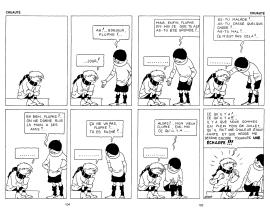 |
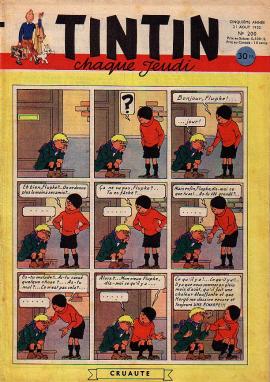 |
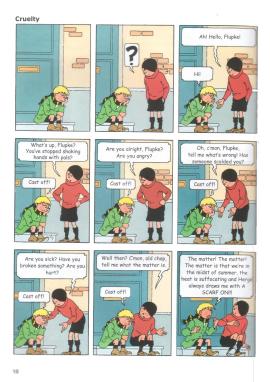 |
|||||||
In this next strip, "les grands moyens" (drastic measures), in a bottom panel on the first page, Flupke gets on the phone with Herge and demands that he do something about the parking ticket he is about to receive. On the next page, we see Herge's hand erasing the no parking sign by Flupke's car. In the next strip, Flupke is blissfully skiing down a wide ski slope on the first page, but then on the second page he crashes into the frame or edge of the cartoon panel. He goes to Herge's office and demands to know why, with all the space on the page, did he have him crash? This English translation is from Excuse Me Ma'am, pg 47-48, published by EuroBooks (India). |
|||||||||
 |
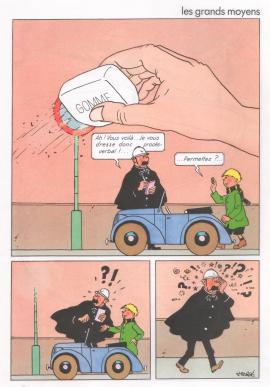 |
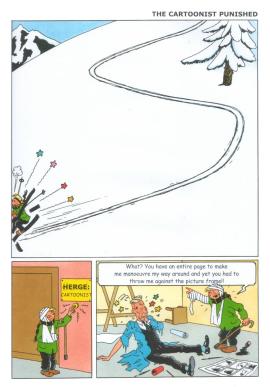 |
|||||||
In the strip below, "une grave affaire" (a serious matter), Quick and Flupke capture Herge and cart him off to the police station. They, along with Officer 15, complain that Herge makes them look ridiculous each week and then force him to write a letter that he will amend his ways. This strip appeared in Le Petit Vingtième, March 2, 1933 (left image) and later in the book Attachez Vos Centures, (Fasten Your Seat Belts) pg 28. The center image is the English translation by David Radzinowicz from the Egmont book, Fasten Your Seat Belts, 2009, while the right panel is from the same book published by EuroBooks (India). Note that the artwork of the blackboard and the two letters are not as well done in the latter book. (Reminder: Click on any image for a supersize image.) |
|||||||||
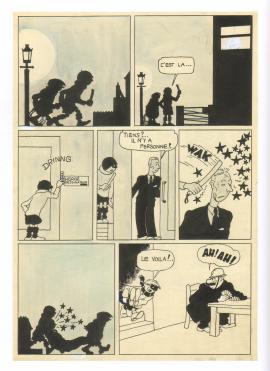 |
 |
 |
|||||||
Quick & Flupke Appear in Tintin comic strips and books Certainly the most often cited cameo appearance is that of Quick & Flupke appearing in the very first panel of The Adventures of Tintin in the Congo. This first appeared in Le Petit Vingtième, June 5, 1930 and was later published in book form by Les Editions du Petit Vingtième and a few months later by Editions Casterman of Tournai. The book was controversial and the English translation did not appear in the UK until 1991 and it was not released in the U.S. until 2002. |
|||||||||
|
|||||||||
| The left image below is from the book, Tintin & Snowy, Album 3, a book of games, puzzles, and activities published by Egmont in 2007. It is an enlargement (11 x 16") of the center portion of the frame discussed above. The center and right images below are from the story, The Shooting Star, which began to appear in Le Soir on October 29, 1941. In this panel, which appears about one third of the way through the story, Quick and Flupke can be seen running towards the docks as the expedition is about to set off. For a variety of reasons, this story required extensive revision before its later release in book form, however, the panel with the Thom(p)sons and Quick & Flupke remained unchanged from Le Soir (center) to the book (right). | |||||||||
|
|||||||||
The only other appearance that might (or might not) be a cameo is from The Seven Crystal Balls in which a pair of boys play a trick on Captain Haddock by hiding a brick under a hat, which Haddock kicks (page 59). We see them two pages over on page 61 and they look slightly similar to Quick and Flupke. However, given Herge's insistence on accuracy, one might question whether this is indeed Quick & Flupke as the event takes place in La Rochelle in France and not Brussels, Belgium where the boys live. |
|
||||||||
| |||||||||
